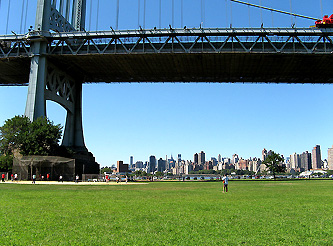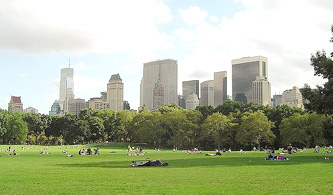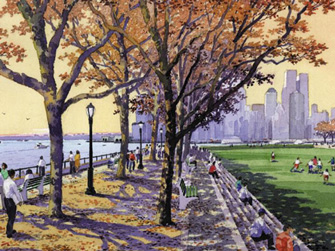Anne Schwartz
Environmental Writer

Private Partnerships For Public Parks

Randall's Island
Last year, the city parks department and the Randall’s Island Sports Foundation worked out a deal to allow 20 private schools near-exclusive use of the island’s ball fields during after-school hours in exchange for contributing $85.5 million over 30 years to help upgrade and maintain the fields. In a city with a steep divide between rich and poor, the agreement seemed to hit a nerve.
Daily News columnist Juan Gonzalez summed up the outrage felt by many (including public officials representing the area) at the notion of privileged private school students locking up public fields during the hours when many schools run sports programs: “No one has explained why public parks, these natural treasures of our great city, are suddenly being converted into private airlines with first-class and coach sections.”
The deal illustrates the complications that can result from the reliance on private organizations to support what traditionally has been a public, taxpayer-funded service. The issue has been raised in park controversies around the city, from the inclusion of apartment buildings within the planned Brooklyn Bridge Park to City Hall’s refusal to allow protesters to gather on the lawn in Central Park.
"The prospective agreement at Randall’s Island is actually forcing all of us to address the park dilemma straight on," said Christian DiPalermo, executive director of New Yorkers for Parks, the advocacy group. "Do we think parks are worthy of public investment so that they may provide universal access, or is it time to move to a model that requires some sacrifice in the universality of parkland in return for essential funding?”
A Key Source of Support for the Parks

Central Park
In the 1970s, after city funding was slashed and the parks fell into disrepair, the Central Park Conservancy pioneered the concept of the private-public partnership to restore the landmark park. Many similar private-public partnerships were started, providing funding, grassroots energy, and innovative ideas to spark a citywide parks revival.
Last week, Bloomberg and the City Council agreed to put more permanent funding into the budget for parks. But the political reality in New York City is that the parks budget is among the first to be cut during times of fiscal crisis. Although the parks budget has held steady in recent years, public funding for operating the parks, once one percent of the city budget, remains just .04 percent. More than 20 large park partnership organizations and dozens of smaller ones help to fill the gap.
The Bloomberg administration has sought to build on and expand this private support. In addition to traditional philanthropy and private partners, it has encouraged corporate donations, concessions, the sale of naming rights, and funding mechanisms that link commercial development with the maintenance of public parks.
Even cities with generous parks budgets have embraced the concept of private groups to support the parks. “No matter how well funded a city’s parks are, they still need some help,” said Andy Wiley-Schwartz, vice president at Project for Public Spaces, a non-profit that works to improve community life through public spaces. “Having community stewards is priceless, and every city knows that, whether they fund parks or not. New York City also happens to need money.”
Private partners can be also more flexible and creative than city agencies that may be set in their ways and bound by union rules. For example, Central Park’s innovative zone management system, in which a gardener has responsibility for a specific section of the park, has proven very effective in keeping high maintenance standards and good community relations. Such groups can also provide a way for people to get more involved in their local park.
The Randall's Deal
The Randall’s Island Sports Foundation was founded in 1992 by parents whose children played sports on the island and who wanted to realize the island’s potential as parkland. The group has raised private and public funding to restore and build new recreational facilities, including the $42 million Icahn track and field stadium, and run free summer and weekend programs for thousands of children in the neighboring communities of East Harlem and the South Bronx.
Under the proposed contract with the private schools, the island would get 65 new and restored fields. The schools would cover half of the debt service on the $70 million cost of constructing the new fields and pay for ongoing maintenance, but use the fields less than 15 percent of the total available hours. The Daily News recently reported that city officials plan to spend an extra $53 million on drainage and other infrastructure improvements as well. “The primary beneficiary of the project is the public,” said Parks Commissioner Adrian Benepe, including the youth and adult sports leagues that play on the island on the weekends and in the summer.
The private schools have been busing students out to the island for years, claiming 95 percent of the fields after school. Their park department permits allow them to continue that use, whether or not the deal goes through. At present, there is not great competition for the fields after school because the island is difficult to get to by public transportation. But the school-age population of the adjacent neighborhoods is increasing, and if access is improved, demand for the fields will increase.
In addition to protesting restricted access to the fields, residents of East Harlem and the South Bronx say the Randall’s Island foundation hasn’t included their communities in planning for the island, has no local representatives on its board, and does not advertise events in their neighborhoods, keeping the island as an enclave for the wealthy.
At a recent City Council hearing on the proposed deal, board members of the Randall’s Island Sports Foundation acknowledged the board did not include representatives from those neighborhoods. But they stressed that the foundation’s goal was to provide a clean, safe place to play for all children. Karen Cohen, the group’s president and founder, said that it is working with 11,000 children from 100 local organizations. She said, “We want to make sure everyone is able to use Randall’s Island.”
Objections to Private Funding
The influence of private funding can extend to how a park is designed, renovated, and used.
A coalition of Brooklyn civic organizations and residents called Brooklyn Bridge Park Defense Fund, which is suing to stop the inclusion of luxury apartment buildings in the Brooklyn Bridge Park to subsidize its upkeep, says the planned towers would make the park into a playground for the residents, not a public park.
The original plan for the waterfront park, developed in a series of community workshops, included stores, a Chelsea Piers-like recreation center, and other uses that would bring people into the park. But when the final plan was released by the Empire State Development Corporation, which is overseeing the construction of the park, it contained luxury apartment buildings, a hotel, and office and retail space. The corporation said that when the actual economic analyses were done, the other commercial uses proved insufficient to generate enough revenue to support the park.
“The fear of privatization in any park is a reasonable fear,” said Marianna Koval, executive director of the Brooklyn Bridge Park Conservancy, which works to support the park. “It is important to strike the right balance. The housing will work to sustain 74 acres in perpetuity. That’s a great thing. Now, how do we protect against privatization from that housing, and across the board in this park?” Her organization is focusing on programming free activities and events in the park that establish “early patterns of use so that people feel welcome.”
A more subtle form of privatization can result when the financial investment by a private group or donor gives them a proprietary interest in a park. The city cedes authority, control, and responsibility to a new class of owner, who has rights and privileges because they are the ones who have to pay off the costs,” said Jonathan Greenberg, founder and coordinator of the Open Washington Square Park Coalition, which is fighting the park department’s redesign of Washington Square Park.
During the Republican National Convention in 2004, the city denied protesters’ request for a permit to rally in Central Park because it said the crowd would damage the carefully restored lawns. Protest organizers charged that the Central Park Conservancy’s interest in protecting the lawns it had paid to restore trumped the more basic right of public assembly.
Greenwich Village residents who are fighting the park department’s design for renovating Washington Square Park see the influence of New York University’s dollars in the redesign calling for a centered fountain and a fenced-in greensward instead of a more modest renovation of the vibrant but somewhat unruly existing space.
Parks Commissioner Benepe rejects that notion, however. “The issue that private dollars are driving the discussion in projects is somewhat of a red herring. It’s a substitute for the fact that some people just don’t like the decisions that are being made,” he said. “There are literally hundreds of projects at some stage of construction, design, and bidding. Unlike with most municipal projects, everybody has an opinion on it.”
Following the Money

Brooklyn Bridge Park (Illustration)
A reliance on private funding, observers say, lets the availability of money, instead of a more systematic assessment of park needs citywide, dictate which park projects will go forward. That can lead to prioritizing projects for affluent areas before meeting the needs of neighborhoods that don’t have private resources at their disposal.
There has been a lot of coverage in the press recently about a new playground near the South Street Seaport where children would use sand, water, and movable blocks to build giant constructions guided by adult “play workers.” Architect David Rockwell is designing this labor-intensive experiment at no charge and raising $2 million to pay for the staff. Meanwhile, the once ubiquitous “parkie” who kept playgrounds clean, unlocked the bathrooms, and kept an eye on children has gone the way of, if not the dinosaur, perhaps the panda. In 2005, the city funded 110 playground associates for the entire city during the summer months, two per City Council district.
The operations of the city’s private-public partnerships can also lack transparency and public accountability, advocates say. Even the extent of private support is not fully known, according to the Independent Budget Office. Between $60 and $70 million a year is provided to parks by partnership organizations, but that represents just part of the total. The budget office did an analysis of private funds spent on public parks at the request of the chair of the City Council parks committee, Helen Foster, but found that it could not give a full accounting because the necessary information was incomplete, out of date, or not publicly available.
In a letter to Councilmember Foster, budget office Director Ronnie Lowenstein wrote, “Since the city continues to rely on private funding for support of its parks and recreation programs, a more through annual accounting of private support would be beneficial in helping the City Council and others determine whether the total resources available for parks and recreation are sufficient and appropriately allocated.”
After the outcry on the Randall’s Island contract, city officials agreed to postpone the final vote by the city's Franchise and Concessions Review Committee and hold further discussions with all of the interested parties. Borough President Scott Stringer, Comptroller William Thompson, East Harlem Councilmember Melissa Mark Viverito and the local community boards have been negotiating to reach a compromise that would allow public school children and local residents to have greater access to the fields during after-school hours. The City Council's parks committee has scheduled another hearing on the issue for January 31. A vote by the franchise committee has been set for February 14.
However the Randall’s Island issue is resolved, the growing importance of private partners to the park system requires a closer look at the trade-offs involved.
“It’s the public sector’s responsibility to provide a framework, to define what it means to be a private partner providing a public service,” said Maura Lout, director of operations at New Yorkers for Parks. “We have to figure out a way to make this work, because we’re obviously going to see more and more of it.”
Editor’s Note: Rich Davis, chairman of the board of directors of Citizens Union Foundation(publisher of Gotham Gazette), is also chairman of the board of trustees of the Randall’s Island Sports Foundation.Dick Dadey, the executive director of Citizens Union Foundation, serves on the board of directors of the Brooklyn Bridge Park Conservancy.